Experimental Study on Axial Stress–Strain Behaviour of Steel Fibre-Reinforced Steel Slag Micropowder UHPC
Abstract
:1. Introduction
2. Experimental Section
2.1. Raw Materials
2.2. Basic Mix Proportion Design
2.3. Experimental Design
2.4. Sample Preparation
- (1)
- Production process
- ➀
- Calculate the materials of each component based on the mix ratio and weigh them for future use.
- ➁
- Pour the weighed cement, silica fume, steel slag micro powder, and river sand into the concrete mixer and pre-mix for 3 min to fully mix the dry material, obtaining the steel slag micro powder UHPC pre-mixed material.
- ➂
- Pour the weighed water and water-reducing agent into a water basin for stirring so that the water-reducing agent is evenly mixed with the water. Then, slowly add it to the steel slag micro powder UHPC pre-mix that is being stirred, and continue stirring for 8 min.
- ➃
- Use tweezers to disperse and evenly add steel fibres into the mixer, continue stirring for 3 min, and complete the preparation of steel slag micro powder UHPC mixture.
- (2)
- Curing of specimens
2.5. Experimental Methods
3. Experimental Results and Analysis
3.1. Mechanical Performance Results
3.2. Failure Process and Morphology
- (1)
- Elastic Stage: Prior to reaching the ultimate load of 40% to 70%, the stress–strain relationship of the specimen follows a proportional growth pattern. In this stage, the compression-induced deformation of the specimen initiates slowly, and microcracks start to form and propagate within the specimen. The load and displacement exhibit a roughly linear relationship, with the curve’s slope remaining relatively constant.
- (2)
- Elastic–Plastic Stage: When the load exceeds 70% of the ultimate load, the slope of the load–displacement curve decreases. Fracturing occurs at the prism’s corners, accompanied by some surface spalling in the edge region. However, due to the micro-reinforcement effect of the steel fibres, the spalled surface maintains some cohesion with the specimen, preventing complete separation. With continued loading, surface microcracks develop and propagate towards the top and bottom of the specimen. Internal microcracks propagate outward, connecting with the surface cracks and intensifying their extension, resulting in the appearance of new cracks. As the load increases, more significant fragmentation occurs, and the cracks rapidly extend and penetrate through the specimen until reaching the peak load.
- (3)
- Failure Stage: After reaching the peak stress, accompanied by a distinct noise, the specimen undergoes splitting failure. Diagonal cracks emerge on the prism’s side surface, intersecting one or multiple concrete specimens. However, due to the reinforcing effect of the steel fibres, even in the event of specimen failure, a certain degree of integrity is maintained. This stands in stark contrast to the failure state of specimen P10 without steel fibres, highlighting the beneficial toughening effect of the steel fibres.
3.3. Analysis of Compressive Peak Strain in Prismatic Specimens
4. The Compressive Constitutive Relationship of Steel Slag Micronized UHPC
4.1. Stress–Strain Curves
4.2. Determination of Constitutive Relationship
- (1)
- The ascending segment of the Guo Zhenhai model exhibited a good fit with the experimental curve, with 1 < < 1.5, while the descending segment displayed a large fitting deviation.
- (2)
- The Jiao Chujie model showed only a few instances of good fit in the ascending segment, with large deviations in other cases, and the stress in the descending segment exceeded that of the experimental curve.
- (3)
- The Ju Yanzhong model underestimated the stress in the ascending segment and exhibited a larger fitting deviation compared to the experimental curve, but it demonstrated a better fit and smaller deviations compared to the previous two models.
4.3. Simulation Model Establishment and Verification
5. Conclusions
- When the steel fibre content in steel fibre-doped steel slag micronized ultra-high-performance concrete (UHPC) is 1%, the axial compressive strength shows an increasing trend with an increase in coarse aggregate content, followed by a decrease. When the steel fibre content is 2%, the axial compressive strength exhibits a slight decrease with an increase in coarse aggregate content. The optimal combination of steel fibre content and coarse aggregate content for achieving the maximum axial compressive strength and peak strain is 1% and 20%, respectively.
- With a constant steel fibre content, the peak strain of each group of specimens shows an initial increase followed by a decrease as the coarse aggregate content increases. Overall, the peak strain ranges from 2985 to 3435 . Based on the experimental variations in the peak strain and axial compressive strength of steel fibre-doped steel slag micronized UHPC, a relationship equation for peak strain strength is obtained through fitting.
- By analysing the measured experimental data, a uniaxial compressive constitutive relation equation is proposed for steel fibre-doped steel slag micronized UHPC, and the calculation formulae for the related parameter values of the constitutive relation equation are provided. The established constitutive relation curve fits well with the experimental curve, and the calculated values have a deviation within 10% of the measured values. This indicates that the selected constitutive relation equation and parameter calculation formulae are reasonably accurate, providing a reference for strength prediction and practical applications of steel fibre-doped steel slag micronized UHPC.
- Finite element software was used to perform a nonlinear analysis of the entire axial compressive process of prism specimens based on the proposed constitutive relation equation in this study, providing effective supplementary information for the measured values. The calculations show that the finite element simulation curve exhibits a similar trend to the experimental curve, and the deviation in the peak load is within 10%. This further verifies the reliability of the proposed constitutive relation equation.
Author Contributions
Funding
Institutional Review Board Statement
Informed Consent Statement
Data Availability Statement
Conflicts of Interest
References
- Graybeal, B.; Bruhwiler, E.; Kim, B.-S.; Toutlemonde, F.; Voo, Y.L.; Zaghi, A. International Perspective on UHPC in Bridge Engineering. J. Bridge Eng. 2020, 25, 04020094. [Google Scholar] [CrossRef]
- Shao, X.; Deng, L.; Cao, J. Innovative steel-UHPC composite bridge girders for long-span bridges. Front. Struct. Civ. Eng. 2019, 13, 981–989. [Google Scholar] [CrossRef]
- Hung, C.-C.; El-Tawil, S.; Chao, S.-H. A Review of Developments and Challenges for UHPC in Structural Engineering: Behavior, Analysis, and Design. J. Struct. Eng. 2021, 147, 03121001. [Google Scholar] [CrossRef]
- Hu, R.; Fang, Z.; Shi, C.; Benmokrane, B.; Su, J. A review on seismic behavior of ultra-high performance concrete members. Adv. Struct. Eng. 2021, 24, 1054–1069. [Google Scholar] [CrossRef]
- Tang, X.Y.; Ma, J.L.; Ro, J.; He, B.B.; Lu, C.J. Steel slag micro-powder ecological super high performance concrete mechanical properties analysis. Silic. Bull. 2023, 42, 607–617. (In Chinese) [Google Scholar]
- Chen, C.; Tang, X.; Ma, J.; Tang, Y.; Shen, S.; Chen, R.; Zheng, J. Analysis of Factors Influencing the Compressive Strength of Steel Slag Micronized Ultra-High Performance Concrete Based on Orthogonal Tests. Highway 2023, 68, 328–332. (In Chinese) [Google Scholar]
- Nguyen, T.V.; Le, A.T. A Study on Steel Slag Replacing Sand in Concrete. In Proceedings of the 4th International Conference on Green Technology and Sustainable Development (GTSD), Ho Chi Minh City, Vietnam, 23–24 November 2018; pp. 821–824. [Google Scholar]
- Zhang, H.R.; Ji, T.; Lin, X.Y. Pullout behavior of steel fibres with different shapes from ultra-high performance concrete (UHPC) prepared with granite powder under different curing conditions. Constr. Build. Mater. 2019, 211, 688–702. [Google Scholar] [CrossRef]
- Zhang, L.; Liu, J.; Liu, J.; Zhang, Q.; Han, F. Effect of Steel Fibre on Flexural Toughness and Fracture Mechanics Behavior of Ultrahigh-Performance Concrete with Coarse Aggregate. J. Mater. Civ. Eng. 2018, 30, 04018323. [Google Scholar] [CrossRef]
- Koksal, F.; Sahin, Y.; Gencel, O.; Yigit, I. Fracture energy-based optimisation of steel fibre reinforced concretes. Eng. Fract. Mech. 2013, 107, 29–37. [Google Scholar] [CrossRef]
- Ma, J.; Orgass, M.; Dehn, F.; Schmidt, D.; Tue, N.V. Comparative Investigations on Ultra-High Performance Concrete with or without Coarse Aggregates. In Proceedings of the International Symposium on Ultra High Performance Concrete, Kassel, Germany, 13–15 September 2004; pp. 205–212. [Google Scholar]
- Li, P.P.; Yu, Q.L.; Brouwers, H.J.H. Effect of coarse basalt aggregates on the properties of Ultra-high Performance Concrete (UHPC). Constr. Build. Mater. 2018, 170, 649–659. [Google Scholar] [CrossRef]
- Luo, M.; Lin, P.; Yang, Z. Study of Uniaxial Compressive Mechanical Properties and Intrinsic Structure Relationship of UHPC. Bridge Constr. 2020, 50, 62–67.8. (In Chinese) [Google Scholar]
- Ma, K.; Ma, Y.; Xing, G.; Liu, B. Behavior of ultra-high-performance concrete columns subjected to axial compressive load. Adv. Struct. Eng. 2021, 24, 3792–3808. [Google Scholar] [CrossRef]
- Zeng, X.; Deng, K.; Liang, H.; Xu, R.; Zhao, C.; Cui, B. Uniaxial behavior and constitutive model of reinforcement confined coarse aggregate UHPC. Eng. Struct. 2020, 207, 110261. [Google Scholar] [CrossRef]
- El-Helou, R.G.; Koutromanos, I.; Moen, C.D.; Moharrami, M. Triaxial Constitutive Law for Ultra-High-Performance Concrete and Other Fibre-Reinforced Cementitious Materials. J. Eng. Mech. 2020, 146, 04020062. [Google Scholar] [CrossRef]
- Guo, X.Y.; Kang, J.F.; Zhu, J.S.; Duan, M.H. Corrosion Behavior and Mechanical Property Degradation of Weathering Steel in Marine Atmosphere. J. Mater. Civ. Eng. 2019, 31, 04019181. [Google Scholar] [CrossRef]
- Williams, E.M.; Graham, S.S.; Akers, S.A.; Reed, P.A.; Rushing, T.S. Constitutive property behavior of an ultra-high-performance concrete with and without steel fibres. Comput. Concr. 2010, 7, 191–202. [Google Scholar] [CrossRef]
- Yu, R.; Fan, D.Q.; Shui, Z.H.; Wang, X. Mix design of ultra-high performance concrete based on the theory of particle compactness. ACTA Silic. 2020, 48, 1145–1154. (In Chinese) [Google Scholar]
- Wang, X. Design and Evaluation of Eco-Type Ultra-High Performance Concrete Based on the Most Compact Packing Theory; Wuhan University of Technology: Wuhan, China, 2018. (In Chinese) [Google Scholar]
- T∕CECS 864-2021; Standard for Test Methods of Ultra-High Performance Concret. Beijing, China, 2021. (In Chinese)
- GB/T50081-2019; Concrete Physical and Mechanical Properties Test Method Standards. Beijing, China, 2019. (In Chinese)
- GB50010-20021; Code for Design of Concrete Structures. Ministry of Housing and Urban-Rural Development of the People’s Republic of China: Beijing, China, 2010. (In Chinese)
- Xue, G.; Zhao, Y.; Zhou, H. Experimental Study on Uniaxial Compressive Stress-Strain Relationship of Steel Slag Coarse Aggregate Concrete. Engineeringmechanics 2022, 39, 86–95. (In Chinese) [Google Scholar]
- Guo, Z. Principle of Reinforced Concrete; Tsinghua University Press: Beijing, China, 2013; pp. 13–20. (In Chinese) [Google Scholar]
- Yang, W.Z.; Bai, X.W.; Li, Y. Study of Axial Compression Principal Structure Relationship of High-Strength Concrete. China Concr. Cem. Prod. 2018, 3, 21–24. (In Chinese) [Google Scholar]
- Lu, X.L.; Zhang, Y.; Nian, X.C. Experimental Study of Axial Compressive Stress-Strain Curves of Steel Fibre High-Strength Concrete Under Monotonic and Repetitive Loading. J. Build. Struct. 2017, 38, 135–143. [Google Scholar]
- T/CECS-2021; Technicai specification for application of high performance concrete in building and road engineering. China Planning Press: Beijing, China, 2021. (In Chinese)
- Jiao, C.J.; Sun, W.; Qin, H.G.; Zhang, Y.; Jiang, J. Uniaxial Compressive Principal Structure Equations for Steel Fibre High-Strength Concrete. J. Southeast Univ. (Nat. Sci. Ed.) 2004, 3, 366–369. [Google Scholar]
- Ju, Y.Z.; Wang, D.H.; Li, Q.; Jia, Y.Z.; Xiao, Q. Effect of Steel Fibre Admixture on Mechanical Properties of Activated Powder Concrete. J. Exp. Mech. 2011, 26, 254–260. (In Chinese) [Google Scholar]
- SIDOROFFF. Description of Anisotroopic Damage Application to Elasticity; Springer: Berlin/Heidelberg, Germany, 1981. [Google Scholar]
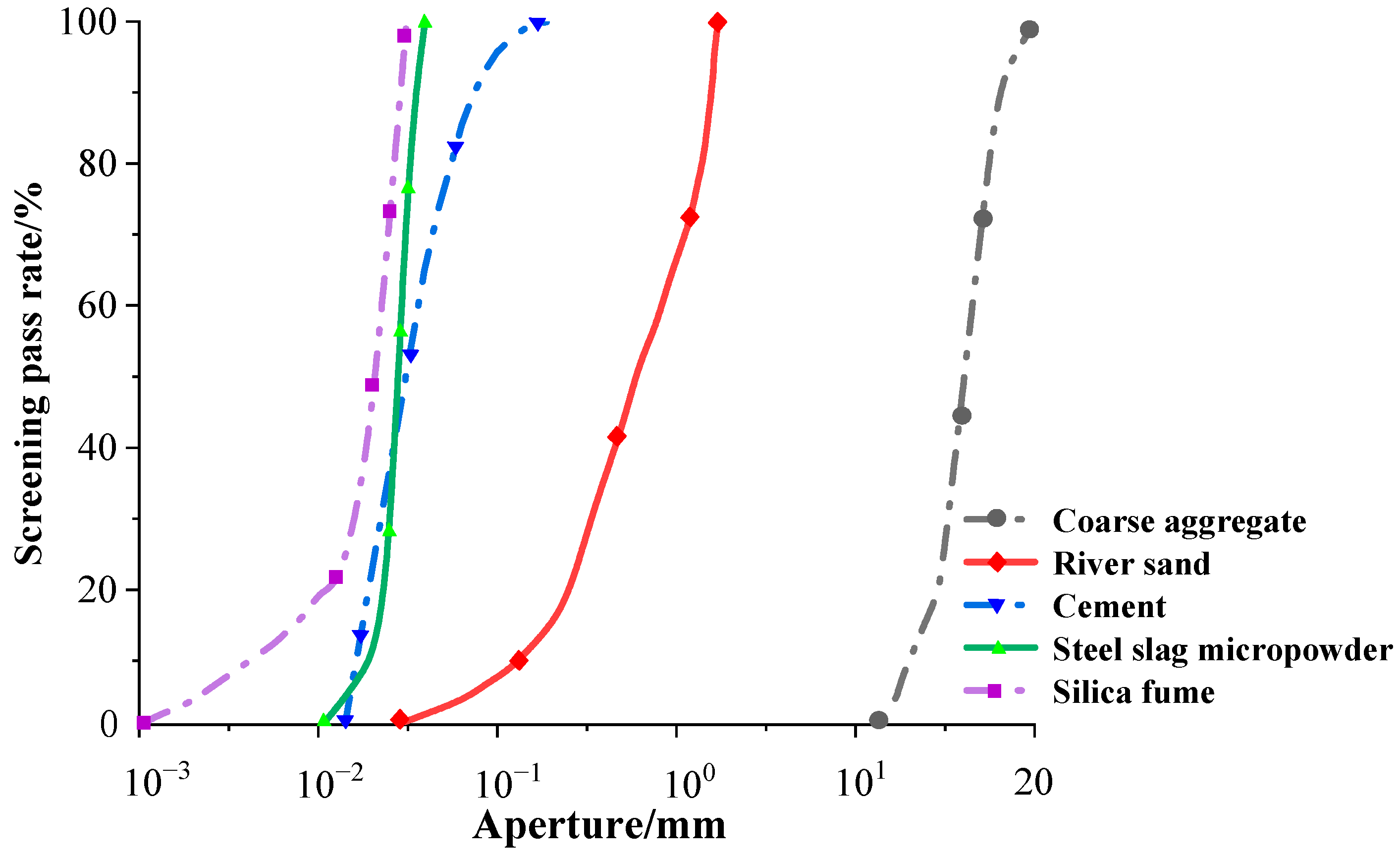


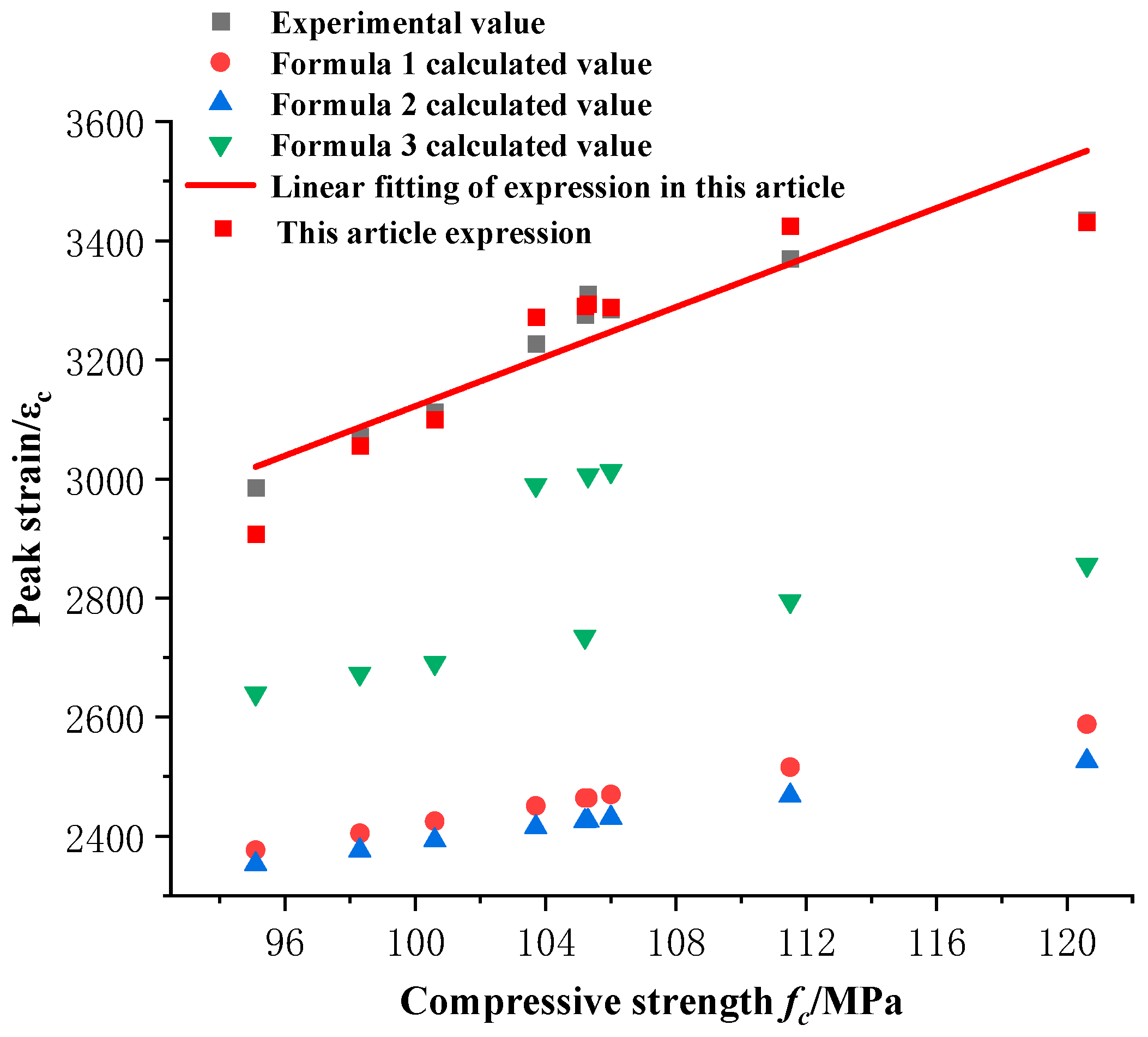



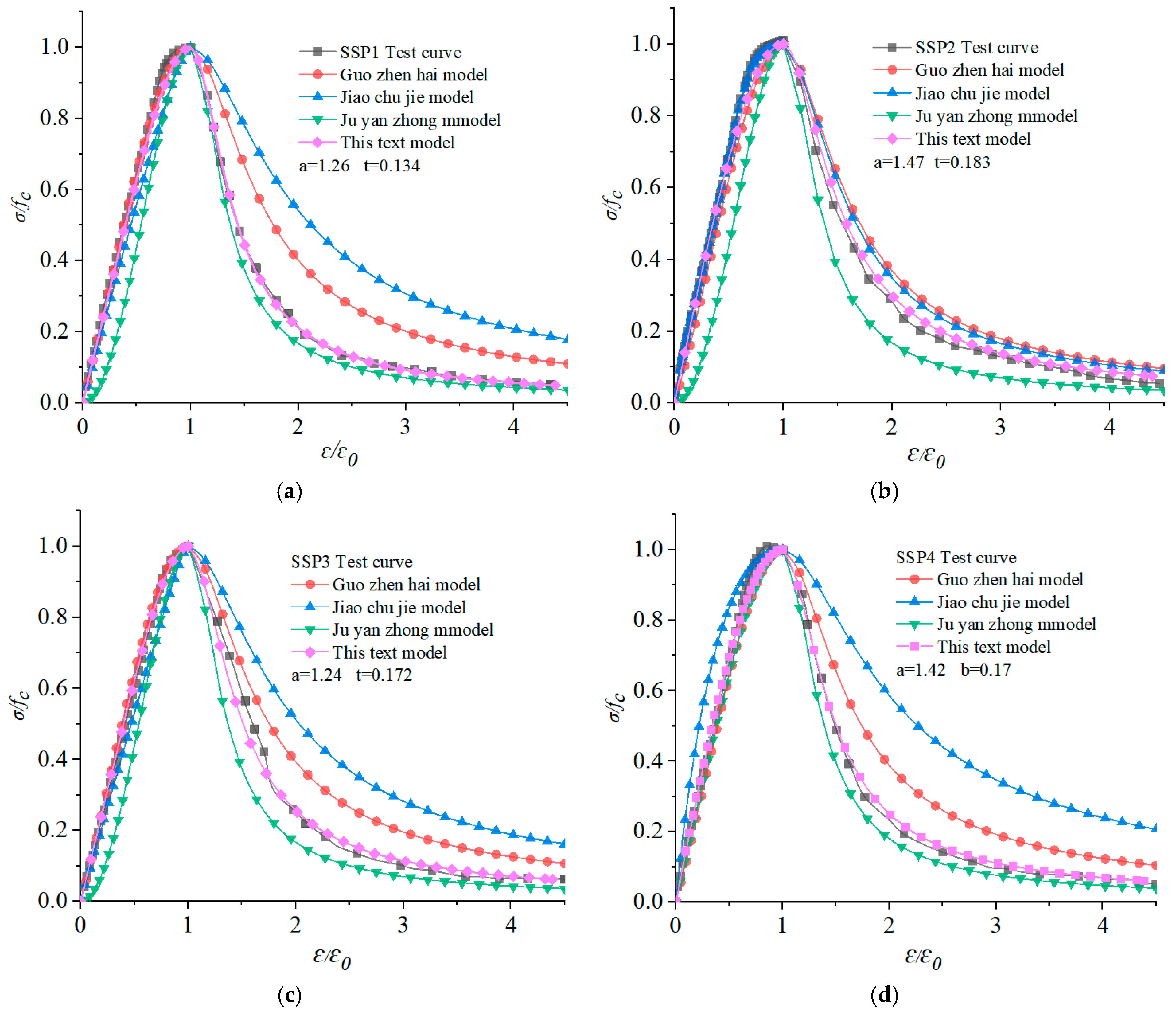

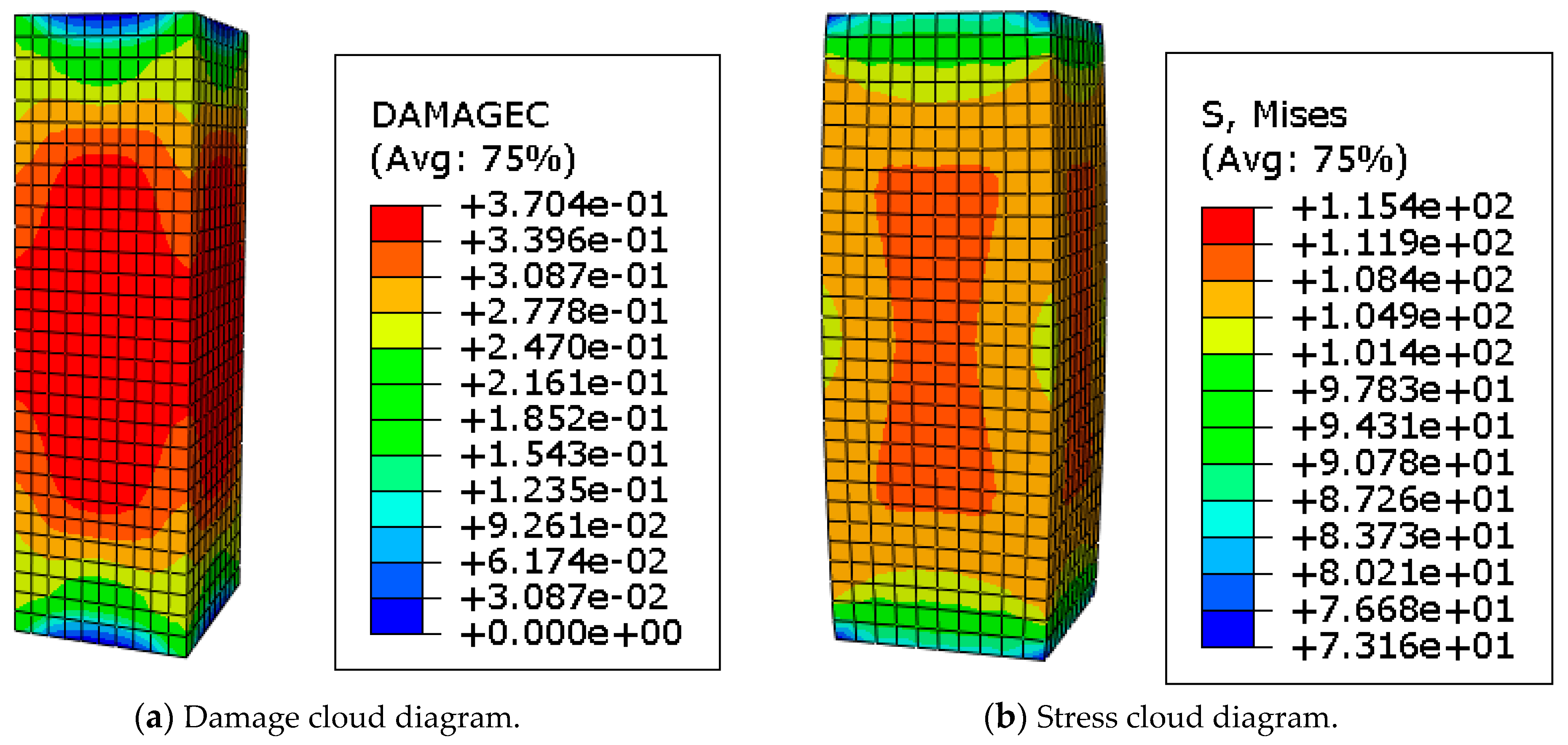
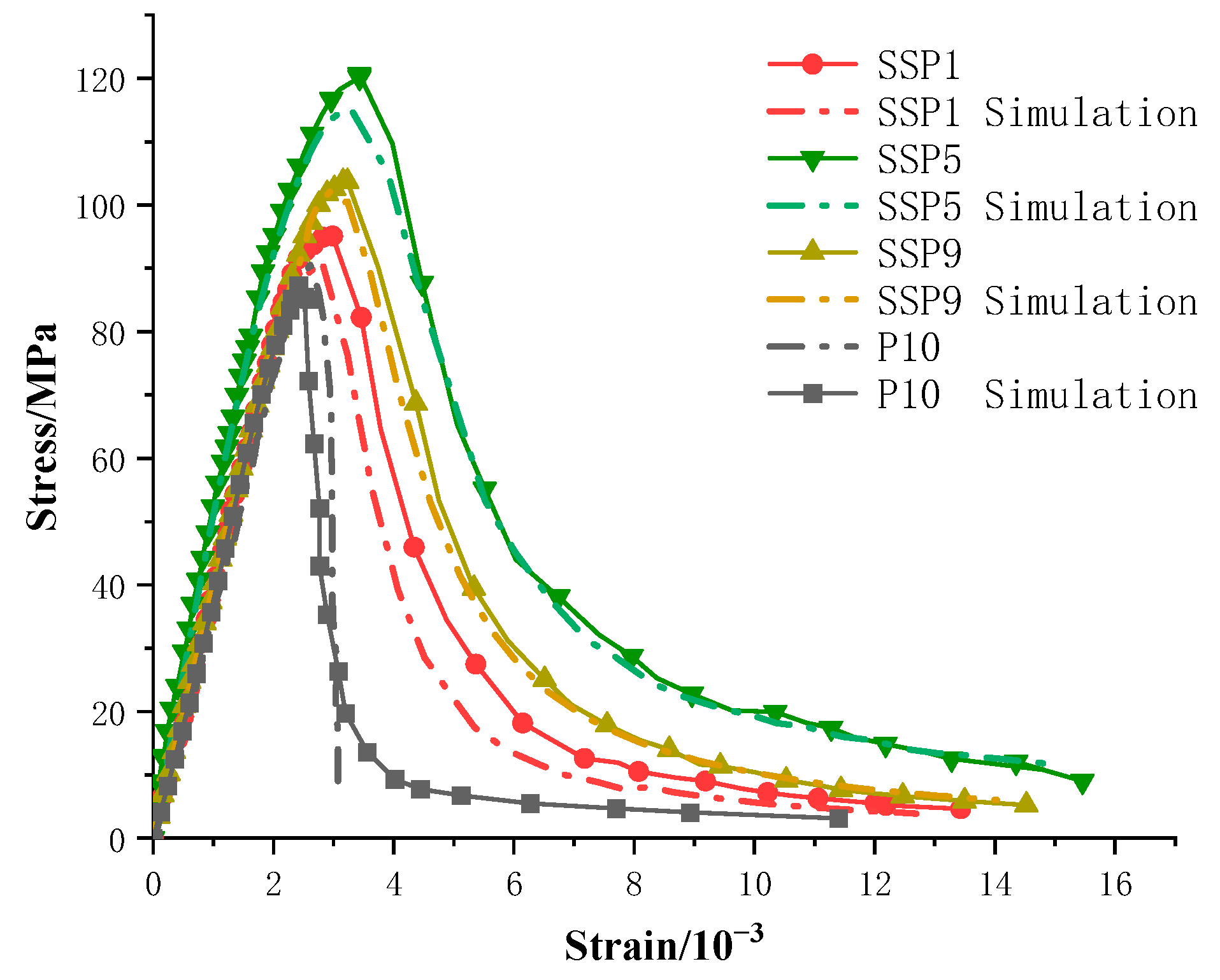
| Material | CaO/% | SiO2/% | Al2O3/% | Fe2O3/% | Fe/% | MgO/% |
|---|---|---|---|---|---|---|
| Cement | 67.12 | 23.45 | 3.46 | 3.23 | / | 2.74 |
| Silica Fume | 1.11 | 93.77 | 2.08 | 0.98 | / | 2.06 |
| Steel Slag | 60.21 | 2.32 | 13.57 | 7.42 | 8.82 | 7.66 |
| Test Number | Cement /(kg/m3) | Silica Fume/(kg/m3) | Steel Slag Micropowder/(kg/m3) | River Sand/(kg/m3) | Crushed Stone/(kg/m3) | Steel Fibre/(kg/m3) | Water/(kg/m3) | Superplasticizer/(kg/m3) | Defoamer/(kg/m3) |
|---|---|---|---|---|---|---|---|---|---|
| SSP1 | 720 | 380 | 140 | 760 | 0 | 78 (1%) | 225 | 12.5 | 4 |
| SSP2 | 576 | 304 | 112 | 608 | 500 (20%) | 78 | 180 | 12.5 | 4 |
| SSP3 | 432 | 228 | 84 | 456 | 1000 (40%) | 78 | 135 | 12.5 | 4 |
| SSP4 | 720 | 380 | 140 | 760 | 0 | 117 (1.5%) | 225 | 12.5 | 4 |
| SSP5 | 576 | 304 | 112 | 608 | 500 | 117 | 180 | 12.5 | 4 |
| SSP6 | 432 | 228 | 84 | 456 | 1000 | 117 | 135 | 12.5 | 4 |
| SSP7 | 720 | 380 | 140 | 760 | 0 | 156 (2%) | 225 | 12.5 | 4 |
| SSP8 | 576 | 304 | 112 | 608 | 500 | 156 | 180 | 12.5 | 4 |
| SSP9 | 432 | 228 | 84 | 456 | 1000 | 156 | 135 | 12.5 | 4 |
| P7 | 720 | 380 | 140 | 760 | 0 | 0 | 225 | 12.5 | 4 |
| Cube Compressive Strength /MPa | Splitting Strength /MPa | Elastic Modulus /GPa | Prism Axial Compression Strength/MPa | Ratio of Prism Axial Compression Strength to Cube Compressive Strength | (Slump/Expansion) /mm | |||
|---|---|---|---|---|---|---|---|---|
| Group | Day 3 | Day 7 | Day 28 | Day 28 | Day 28 | Day 28 | Day 28 | |
| SSP1 | 87.7 | 106.4 | 118.4 | 8.1 | 43.4 | 95.1 | 0.80 | 212/462 |
| SSP2 | 94.4 | 120.8 | 135.1 | 11.2 | 49.1 | 111.5 | 0.83 | 207/451 |
| SSP3 | 109.3 | 113.0 | 120.4 | 9.1 | 44.2 | 98.3 | 0.82 | 188/432 |
| SSP4 | 114.5 | 125.3 | 124.7 | 8.7 | 47.5 | 100.6 | 0.81 | 210/455 |
| SSP5 | 109.7 | 122.2 | 147.5 | 14.7 | 51.4 | 120.6 | 0.82 | 203/450 |
| SSP6 | 109.3 | 113.0 | 130.2 | 12.6 | 46.3 | 105.2 | 0.81 | 194/434 |
| SSP7 | 111.3 | 123.9 | 130.7 | 9.4 | 46.8 | 106.0 | 0.81 | 205/452 |
| SSP8 | 103.3 | 114.5 | 126.7 | 9.8 | 45.7 | 105.3 | 0.83 | 195/438 |
| SSP9 | 111.8 | 117.8 | 121.7 | 9.5 | 45.2 | 103.7 | 0.85 | 180/422 |
| Average value | 105.7 | 117.4 | 128.4 | 10.3 | 46.6 | 105.1 | 0.82 | 199/444 |
| P10 | 91.7 | 103.2 | 112.1 | 5.6 | 40.3 | 90.5 | 0.80 | 220/481 |
| Group | Steel Fibre Content/% | Coarse Aggregate Content /% | Compressive Strength /MPa | Peak Strain /10−6 |
|---|---|---|---|---|
| SSP1 | 1 | 0 | 95.1 | 2985 |
| SSP2 | 1 | 20 | 111.5 | 3370 |
| SSP3 | 1 | 40 | 98.3 | 3071 |
| SSP4 | 1.5 | 0 | 100.6 | 3112 |
| SSP5 | 1.5 | 20 | 120.6 | 3435 |
| SSP6 | 1.5 | 40 | 105.2 | 3275 |
| SSP7 | 2 | 0 | 106 | 3285 |
| SSP8 | 2 | 20 | 105.3 | 3310 |
| SSP9 | 2 | 40 | 103.7 | 3227 |
| Average | 105.1 | 3277 | ||
| P10(No Steel Fibre) | / | / | 90.5 | 2611 |
| Author | Peak Strain–Strength Relationship |
|---|---|
| Guo Zhenhai [25] | |
| Yang Weizhong [26] | |
| Lv Xilin [27] | |
| This study |
| Presenter | The Relationship Equation of This Structure | Parameter Meaning |
|---|---|---|
| Jiao Chujie [29] | : Steel fibre volume fraction ascending segment parameters descending segment parameters | |
| Ju Yanzhong [30] | : Steel fibre volume fraction : ascending segment parameters : descending segment parameters | |
| Guo Zhenhai | Ascending segment parameters descending segment parameters | |
Disclaimer/Publisher’s Note: The statements, opinions and data contained in all publications are solely those of the individual author(s) and contributor(s) and not of MDPI and/or the editor(s). MDPI and/or the editor(s) disclaim responsibility for any injury to people or property resulting from any ideas, methods, instructions or products referred to in the content. |
© 2023 by the authors. Licensee MDPI, Basel, Switzerland. This article is an open access article distributed under the terms and conditions of the Creative Commons Attribution (CC BY) license (https://creativecommons.org/licenses/by/4.0/).
Share and Cite
Tang, X.; He, B.; Yang, B.; Chen, J. Experimental Study on Axial Stress–Strain Behaviour of Steel Fibre-Reinforced Steel Slag Micropowder UHPC. Appl. Sci. 2023, 13, 8807. https://doi.org/10.3390/app13158807
Tang X, He B, Yang B, Chen J. Experimental Study on Axial Stress–Strain Behaviour of Steel Fibre-Reinforced Steel Slag Micropowder UHPC. Applied Sciences. 2023; 13(15):8807. https://doi.org/10.3390/app13158807
Chicago/Turabian StyleTang, Xianyuan, Binbing He, Bai Yang, and Junhua Chen. 2023. "Experimental Study on Axial Stress–Strain Behaviour of Steel Fibre-Reinforced Steel Slag Micropowder UHPC" Applied Sciences 13, no. 15: 8807. https://doi.org/10.3390/app13158807
APA StyleTang, X., He, B., Yang, B., & Chen, J. (2023). Experimental Study on Axial Stress–Strain Behaviour of Steel Fibre-Reinforced Steel Slag Micropowder UHPC. Applied Sciences, 13(15), 8807. https://doi.org/10.3390/app13158807







